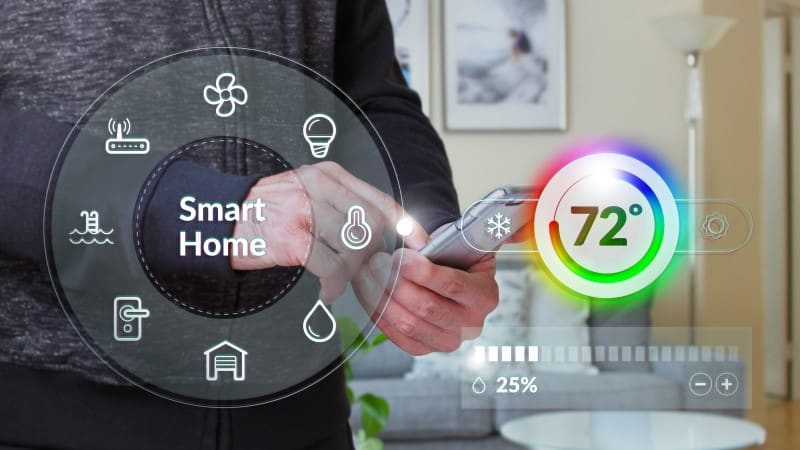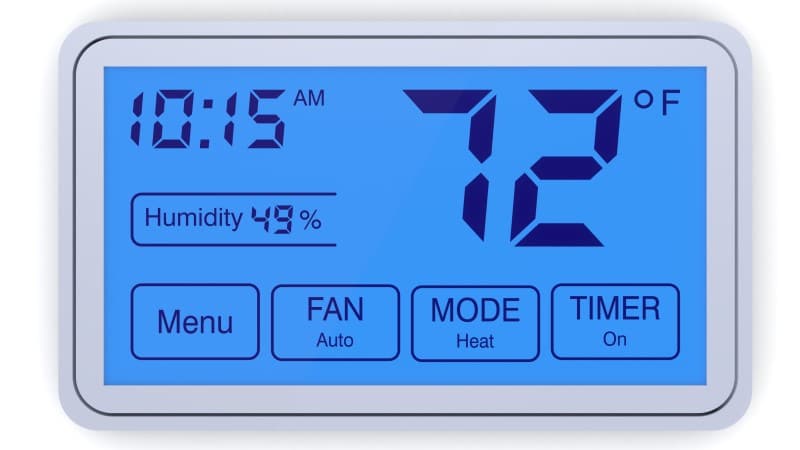Smart Thermostats Vs Regular And Programmable Thermostats

As the Texas summer gets into full swing, many homeowners adjust their thermostats to ensure a comfortable indoor temperature. While traditional thermostats have served us well in the past, the rise of smart technology has introduced an entirely new way of managing our heating and cooling systems.
Smart thermostats are becoming increasingly popular, thanks to their ability to offer energy savings, convenience, and advanced features. As we compare smart thermostats with regular and programmable thermostats, it is important to understand the differences between the three types.
While regular thermostats are simple and straightforward, programmable thermostats have the advantage of being able to adjust temperature settings at different times of the day. Smart thermostats, on the other hand, take things a step further by allowing homeowners to control their heating and cooling systems from their smartphones, adjust temperature settings based on their location, and even learn their preferences over time.
In this article, we will explore the benefits and limitations of each type of thermostat, and help homeowners decide which option is best for their specific needs.
Key Takeaways
- Smart thermostats are designed to manage climate-control systems in a way that traditional and programmable thermostats can't, making them a worthwhile upgrade for many heating and cooling systems.
- Smart thermostats can help most users save money on utility bills, with an average of 8% savings, and offer features like motion sensors and geo-fencing that help save energy.
- Smart thermostats are easier to use than regular programmable thermostats, especially those with app-based interfaces, and have learning algorithms that try to automatically set a heating and cooling schedule based on user habits.
- While smart thermostats may not save as much money in temperate climates with lower energy bills, they can still trim costs by about 8% on average and may be worth the investment in places with hot summers and frigid winters and high energy costs.
What a Thermostat Does
Understanding what a thermostat does is crucial to fully grasping the benefits of smart thermostats, which are designed to manage climate-control systems in a way that traditional and programmable thermostats cannot.
- Regular thermostats are basic temperature controls that allow users to adjust the temperature manually.
- Programmable thermostats allow users to set temperature schedules in advance, but they require manual input and do not adapt to user behavior.
- Smart thermostats utilize advanced technology to learn user preferences, adjust settings automatically, and maximize energy efficiency.
Smart thermostats offer a wide range of features that set them apart from traditional and programmable thermostats.
- Detect presence through sensors and geolocation, adjust temperature settings based on the user's schedule, and provide remote control through smartphone apps or voice assistants.
- Learning algorithms that anticipate user preferences and automatically adjust temperature settings accordingly.
- Analyze energy usage and suggest ways to save money on heating and cooling costs.
Energy efficiency is a key advantage of smart thermostats.
By automatically adjusting temperature settings based on user behavior and preferences, they can save energy and reduce utility bills.
Regular and programmable thermostats, on the other hand, require manual input and do not adapt to user behavior, which can result in wasted energy and higher costs.
Overall, smart thermostats offer a more efficient and convenient way to manage climate-control systems, making them a worthwhile investment for many homeowners.
Types of Thermostats
This section will discuss the different types of thermostats available:
- Standard thermostats: the simplest and most basic type, providing basic temperature control.
- Programmable thermostats: allow for scheduled temperature changes.
- Smart thermostats: offer advanced features such as learning algorithms, remote control through apps, and integration with other smart home devices.
Each type has its own advantages and limitations. Understanding the differences between them can help homeowners make informed decisions about which type of thermostat is best suited for their needs.
Standard
The traditional, non-programmable thermostats lack the advanced features and learning algorithms of smart thermostats, resulting in higher energy bills and a less efficient use of resources. They require constant adjustment to maintain a comfortable temperature, leading to unnecessary AC power usage and increased costs. Additionally, manual thermostats do not have the ability to learn the household's schedule and preferences, resulting in a less personalized and less efficient use of energy.
Programmable

Programmable thermostats allow users to set a heating and cooling schedule, reducing energy usage and costs compared to manual thermostats. However, they lack the advanced features of smart thermostats, such as learning algorithms and remote control capabilities. They require manual thermostat programming to set a schedule, which can be tedious and time-consuming. Additionally, they do not have the ability to learn user habits and adjust the temperature accordingly.
While programmable thermostats are a step up from regular thermostats, they do not offer the same level of energy savings and convenience as smart thermostats.
Smart
Adoption of green technology like smart thermostats is changing the energy industry, with some models equipped with built-in AI that can knock as much as 30% off heating and cooling bills. Smart thermostats are designed to manage climate-control systems in a way that traditional thermostats cannot.
- They learn a household's schedule and anticipate preferred temperature settings, detect presence through sensors and geolocation, and allow adjustments through app or voice assistant. The best models perform setbacks to save energy by turning down heat or reducing AC when not in use. They calculate how long it takes to heat and cool a home for scheduling.
- Compared to regular and programmable thermostats, smart thermostats save energy by turning off the heat and AC more often, without sacrificing comfort. They have common features like motion sensors and geo-fencing that help save energy.
- They are easier to use than regular programmable thermostats, especially those with app-based interfaces.
- Learning algorithms try to automatically set a heating and cooling schedule based on user habits.
- Smart thermostats remind users to replace their HVAC filter.
- Some smart thermostats connect to programs that allow utility companies to adjust thermostat settings in exchange for incentives.
- They can save energy while maintaining or improving comfort in the home.
- Some of the more popular brands of smart thermostats include: Nest (Google), ecobee, Honeywell, Emerson, Levoit, Cielo, Bosch and Sensi.
Even the most advanced smart thermostat can't compensate for a malfunctioning AC unit. If you're noticing performance issues with your AC even after optimizing your thermostat settings, it might be time for an AC repair. Visit our AC repair page to learn more about common issues and how Dallas Heating and Air Conditioning can help keep your home comfortable and energy-efficient.
Benefits and Limitations of Each Type
Smart thermostats, while offering convenience and potential energy savings, may not be as effective for homes with radiant heating systems compared to homes with central HVAC systems. Radiant systems primarily heat up people and objects, and smart thermostats may not be as efficient in regulating temperatures. However, some smart thermostats can still find ways to save energy with radiant systems by adjusting temperature settings based on occupancy and usage patterns.
It's important to consider the limitations of each type. Regular thermostats have no programming options and may not save as much energy compared to programmable or smart thermostats. Programmable thermostats allow for more precise temperature control and scheduling, but may still require manual adjustments and can be difficult to program. Smart thermostats offer the most features, such as learning algorithms, remote access, and integration with other smart home devices, but can be more expensive and may not be compatible with all HVAC systems.
Overall, the choice of thermostat depends on the specific needs and preferences of each homeowner. It is important to consider factors such as home energy use, HVAC system compatibility, and budget when deciding which type of thermostat to install.
Smart thermostats, with their built-in AI and advanced features, can provide the most potential energy savings and convenience, but may not be necessary or cost-effective for every home.
Cost and Energy Efficiency Analysis
The cost of upgrading a home's thermostat and its impact on energy efficiency is an important consideration for homeowners. Smart thermostats are more expensive than regular and programmable thermostats, with prices ranging from $100 to $500. However, they offer features like learning algorithms, remote temperature sensors, and integration with other smart home devices that can help save energy and lower utility bills.
According to a study "Energy Efficiency Effectiveness of Smart Thermostat Based BEMS", the researchers have scientifically proven that a smart temperature control system will save home and business owners money in the long run.
According to data from two separate studies conducted on real-life Nest users, the use of smart thermostats can lead to an average savings of 10-12% on heating costs and about 15% on cooling expenses. Nest itself estimates that these savings could translate to around $140 a year off your energy bills, based on typical energy cost structures. However, it's worth noting that these figures aren't set in stone. Savings can vary depending on a number of factors such as the size of your home and your specific energy use habits.
Looking at another smart thermostat brand, ecobee, they conducted an internal customer analysis back in 2013. Their customers experienced up to a 23% decrease in heating and cooling costs, which might put an extra $200 back into their pockets each year.
In addition to the initial cost of the thermostat upgrade, there may also be installation costs and extra tools or materials required. However, some states, local city governments, and energy providers offer rebates and discounts for smart thermostat purchases.
While the investment in a smart thermostat may not make sense for all homeowners, those living in places with hot summers and frigid winters and high energy costs may find it to be worth the cost for the potential energy savings and convenience.
Factors to consider when choosing a thermostat
Choosing the right thermostat can have a significant impact on a homeowner's energy usage and utility bills. There are several factors to consider when choosing a thermostat, such as the type of HVAC system in the home, the homeowner's schedule, and the desired level of control and automation.
One option for homeowners looking to upgrade their thermostat is AI thermostats, which use machine learning algorithms to learn a homeowner's schedule and preferences and adjust temperature settings accordingly.
However, it's important to keep in mind that not all AI thermostats are created equal, and some may have limitations depending on the type of HVAC system in the home. For example, some thermostats may not work with certain HVAC systems or require additional equipment, such as C-wire adapters, to function properly.
It's also important to consider the cost of installing a wifi thermostat, which can range from $100 to $500, plus installation costs and extra tools or materials.
When choosing a thermostat, homeowners should weigh the benefits of upgrading to a smart or AI thermostat against the potential cost and limitations. While a thermostat upgrade can provide greater control and automation, it may not be necessary or cost-effective for all homeowners.
Ultimately, the decision to upgrade to an AI thermostat should be based on a homeowner's individual needs and preferences, as well as the compatibility of the thermostat with their HVAC system.
Frequently Asked Questions
Can smart thermostats be controlled manually, or do they rely solely on learning algorithms?
Smart thermostats can be controlled manually through the app or voice assistant, and they also rely on learning algorithms to set heating and cooling schedules based on user habits. They offer convenience and energy savings, especially for homes with central air conditioning and furnace-based heating systems.
Are there any potential downsides to using a smart thermostat?
Like any technology, smart thermostats have potential downsides. They may not be compatible with certain HVAC systems, and may not save as much money in temperate climates. However, for homes with central air and furnace-based heating systems, the benefits of saving energy and improving comfort may be worth the investment.
How long does it typically take to recoup the cost of a smart thermostat through energy savings?
The typical timeframe for recouping the cost of a smart thermostat through energy savings varies depending on factors such as energy costs and usage patterns, but it can be as little as one to two years and up to five years or more.
Can smart thermostats be integrated with other smart home devices, such as smart light bulbs or door locks?
Most smart thermostats can be integrated with other smart home devices, providing a convenient and cohesive home automation system. So you can consolidate all your smart devices into a single app and have those devices interact with one another.
Are there any state or federal incentives available for purchasing and installing a smart thermostat?
There are several state and federal incentives available for purchasing and installing a smart thermostat, including rebates and discounts from energy providers, states, and local city governments. These incentives can help offset the cost of the investment and promote the adoption of green technology. In North Texas, Atmos Energy's website lists rebates for smart thermostats, as does Oncor's website.
Are smart thermostats tax deductible?
No. There are no energy tax credits for installing a smart thermostat.
Conclusion
Upgrading to a smart thermostat can bring a significant improvement to your home's comfort level and energy efficiency. With potential savings on heating and cooling costs, it's an investment that not only pays for itself over time but also contributes to a more sustainable future. However, the transition to a smart thermostat should be handled with professional expertise to ensure it's set up and functioning correctly for optimal performance.
Here at Dallas Heating and Air Conditioning, we specialize in smart thermostat installation and maintenance, providing you with peace of mind and maximum comfort. Don't wait to start saving on your energy bills and enhancing your home's comfort. Give Dallas Heating and Air Conditioning a call today to schedule a consultation or service appointment. Let us help you make the smart choice for your home's heating and cooling system.
If you enjoyed this article, check out these other articles about air conditioning repair:
What’s The Best Temperature Setting For Your AC?
Should I Repair Or Replace My Air Conditioner?


